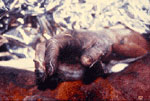What is a thermal burn? How are they classified?

The mechanism of chemical burn injuries
Burns are topical or more systemic damages to the skin and the subcutaneous tissues. 85% of cases are due to thermal burns resulting from a contact with flames, with a boiling liquid or with a hot object.
Every year, there are more than 300 000 burns in France, among which, 3 000 serious burns requiring hospitalization and 300 fatalities. Burns are the second cause of accidental death in France.
A large number of factors impact the cicatrization of burns: the damaged surface, the patient’s age, the quality of management and the quality of topical treatment. However, even minor burns must be dully treated because they may induce numerous complications.
Thermal burns are classified in three degrees
| SUPERFICIAL | First-degree | Red skin = erythema (i.e. sunburns) | Healing within 48 h |
| SUPERFICIAL | Superficial second-degree | Blisters – thick walls – exuding base – pain | Healing within 15 days – skin pigmentation disorders |
| INTERMEDIATE | Deep second-degree | Lower pain – partial anaesthasia | Low quality cicatrization within 3 weeks |
| DEEP | Third-degree | White or brown leather-like and painless skin | Requires transplantation |
The extent of burns is to be considered too
- In broad outline, burns are severe when they spread on more than 1% of the body surface (1% = the size of the victim’s hand). “People with serious burns” applies to people with 25% damaged surface in adult and 15% burnt surface in child.
- The first hours of development of serious burns impact each and every future development.
The immediate management of burn victims is crucial. - Indeed, to be efficient the cooling of burn injuries must be instantaneous and its interest becomes limited after the first 15 minutes.
- First-aid workers are in charge of the early cooling. The cooling may be performed with 20°C water for 15 mn or with water gels (such as Water Jel®), which allow to focus better on the burnt areas only and moreover bring an analgesic effect.
- Cooling must be shorter in more vulnerable victims (from 3 to 5 mn in child).
